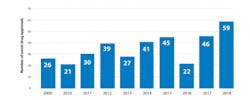Last year, the FDA once again set a new record for new drug approvals and far surpassed its 10-year average.
Since being sworn in as FDA commissioner in 2017, Scott Gottlieb has made drug approvals a top priority for the agency. In 2018, the FDA made moves to streamline its entire drug approvals process — from early development to final application submissions.
And as the country grapples with the issue of drug prices, the FDA has also found ways to significantly shorten the application process for generics and help bring more low-cost alternatives onto the market at a faster clip.
Gottlieb recently said that the agency will keep up these efforts in 2019. For example, the FDA plans to continue removing barriers to generic drug competition by helping ensure access to brand-name biologic drug samples and cutting back on the number of review cycles companies have to go through to get generics approved.
CDER Drug Approvals
But before zipping ahead, here’s a look back at drug approvals in 2018, by the numbers.
59 = New molecular entities (NMEs) approved by the FDA’s Center for Drug Evaluation and Research (CDER) in 2018. The figure is a significant jump from the 46 approvals in 2017 and shatters the 10-year average of 33.
64 = The percentage of NMEs that were small molecules. About 20 percent of the NMEs were antibodies.
34 = NMEs approved in 2018 that were orphan drugs (58 percent) that target rare diseases (affecting 200,000 or fewer Americans). Among these approvals were treatments for a rare, inherited form of rickets, a serious genetic condition called phenylketonuria, and a treatment for seizures associated with a rare form of epilepsy (the medication, Epidiolex, was also the FDA’s first-ever approved drug containing cannabidiol, which is derived from marijuana).
19 = The number of approvals that were first-in-its-class therapies. These treatments target a wide range of conditions including opioid use disorder, Fabry disease, HIV and more.
16 = Cancer drugs approved by the FDA in 2018 — up from 12 in 2017. Seven of the newly approved treatments target some kind of blood cancer.
3 = New preventative migraine treatments approved in 2018. The three drugs — Aimovig, Ajovy and Emgality — offer a first-of-its-kind approach to reducing migraines and have become high-profile competitors in a global market for migraine treatments that could reach $8.7 billion by 2026.
73 = The percentage of NME approvals that CDER expedited with at least one development or review method to speed approvals.
971 = The number of generics that were approved or tentatively approved in 2018 — this record-breaking figure is an increase from 937 in 2017. According to Gottlieb, the arrival of these generics into the market saved American consumers $26 billion between January 2017 and July 2018 alone.
110 = Generics approved in October 2018 alone — a new, single-month record. That figure includes 23 first-time generics and 17 complex generics.




